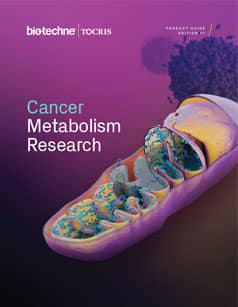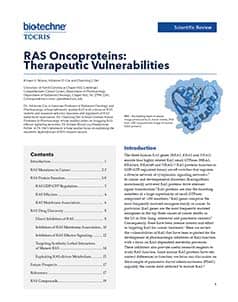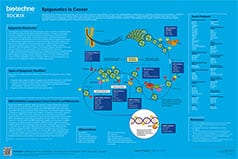Ras GTPases
Ras GTPases are prototypical members of the RAS superfamily and regulate cytosolic signaling pathways involved in gene expression, as well as regulation of cell proliferation, differentiation and survival. In humans there are three RAS genes, which are the most commonly identified oncogenes, found in approximately 20-30% of all cancers.
Ras GTPase Inhibitors |
|
|---|---|
| Cat. No. | 产品名称/活性 |
| 7713 | AMG 510 |
| Potent and selective KRASG12C inhibitor | |
| 6791 | BC-LI-0186 |
| Leucyl-tRNA synthase (TRS)/Ras-related GTP-binding protein D (RagD) interaction inhibitor | |
| 6407 | Fendiline Hydrochloride |
| Inhibits KRas localization to the plasma membrane; also L-type calcium channel blocker | |
| 5607 | GNF 7 |
| Ras signaling inhibitor; inhibits Ack1 and GCK | |
| 6429 | ML 210 |
| Selectively kills mutant HRAS-expressing cells; glutathione peroxidase inhibitor; induces ferroptosis | |
| 7488 | MRTX 849 |
| Mutation-selective inhibitor of KRASG12C | |
| 6111 | Zoledronic Acid |
| Ras signaling inhibitor; also potent farnesyl diphosphate (FPP) synthase inhibitor | |
Degraders |
|
| Cat. No. | 产品名称/活性 |
| 7420 | LC 2 |
| Selective KRAS PROTAC® | |
Controls |
|
| Cat. No. | 产品名称/活性 |
| 7421 | LC 2 Epimer |
| Negative control for LC 2 (Cat. No. 7420) | |
Other |
|
| Cat. No. | 产品名称/活性 |
| 5424 | Deltarasin |
| High affinity PDEδ-KRas interaction inhibitor; binds to PDEδ | |
RAS Structure and Function
There are three human RAS genes; HRAS, KRAS and NRAS, which encode four highly related 188-189 amino acid proteins, HRAS, KRAS4A, KRAS4B and NRAS. KRAS encodes two spice variants, with 4B being widely expressed and 4A more tissue restricted. The C-terminal 24/25 amino acid sequence exhibits the greatest divergence between the different isoforms and contain sequences that facilitate membrane interactions.
Ras proteins function as GDP-GTP regulated binary on-off switches that regulate a diverse network of cytoplasmic signaling networks. Wild-type Ras proteins exhibit low picomolar affinity for GDP and GTP function. Wild-type RAS proteins exist in an inactive GDP-bound state. Upon stimulation of cell surface receptors (e.g. EGFR) by extracellular stimuli, cytoplasmic signaling components are activated, which in turn activate RAS-selective guanine nucleotide exchange factors (RASGEFs; e.g., SOS1), stimulating rapid and transient GDP-GTP exchange and formation of the active GTP-bound protein. In the active GTP-bound state, Ras proteins have high affinity for Ras-binding domains on Ras effectors. Ras effectors include PI 3-K and RAF, which interact with multiple intracellular signaling pathway members, including MEK, ERK, and MYC as well as the PI3K/AKT/mTOR pathway.
The Ras active state is rapidly terminated by GTPase activating proteins (RASGAPs; e.g., neurofibromin) that stimulate the weak intrinsic GTPase activity of RAS, hydrolyzing the bound GTP to GDP, returning RAS to the inactive state.

Figure 1: Ras Effectors. Schematic outlining the effectors validated to drive RAS-dependent cancer growth. Activated RAS-GTP recognizes RAS Binding (RBD) or RAS Association (RA) Domains. Image reproduced from: RAS Oncoproteins - Therapeutic Vulnerabilities. Bryant, KL et al. Tocris Scientific Review Series.
RAS and Cancer
RAS genes are the most frequently mutated oncogene family in cancer and are found in approximately 25% of all cancers. RAS proteins are therefore of interest as targets for the development of cancer treatments.
The three RAS genes are mutationally activated, however, the frequency of RAS missense mutations is not uniform among cancer types. For example, PDAC, the predominant form of pancreatic cancer, exhibits the highest frequency (95%) of RAS mutations, whereas in breast cancers mutant RAS genes are rare (<2%). In addition, the frequency of missense mutations is different for the three RAS genes: mutations in KRAS make up 85% of all RAS mutations in cancer, followed by NRAS (12%), while mutations in HRAS comprise only 3% of all cancer mutations. Whereas KRAS is the predominant RAS isoform mutated in PDAC (a form of pancreatic cancer), colorectal and lung adenocarcinoma, NRAS is the predominant isoform mutated in melanoma and acute myelogenous leukemia. Although rare overall, HRAS mutations are predominant in bladder and in head and neck squamous cell carcinomas.
RAS Inhibitors
RAS inhibitors have been developed that target RAS directly, modulate RAS subcellular localization and membrane association or that inhibit RAS effectors. Such compounds have enabled the exploration of RAS and its downstream signaling pathways. In addition, inhibitors of RAS function have been developed as cancer therapies.
Featured Product: LC 2
More recently Protein Degraders, such as LC 2 (Cat. No. 7420), have been developed which knockdown an entire protein, removing all possible functions - unlike an inhibitor which blocks or modifies a protein. LC 2 brings about the proteasomal degradation of mutant KRASG12C in cancer cells lines, resulting in suppression of MAPK signaling. This approach may help the further elucidation of the role of Ras, and has potential in treating cancers.
To learn more about LC 2, read our blog post: Development of a KRAS-targeting PROTAC®.
Resources for RAS GTPase Research
RAS Oncoproteins Webinar
RAS proteins function as binary on-off switches that regulate diverse cytoplasmic signaling networks. In cancer and developmental disorders (RASopathies), mutationally activated RAS proteins drive aberrant signal transduction. This webinar discusses the vulnerabilities of RAS that have been exploited for the development of pharmacologic inhibitors of RAS function.
Watch RAS Oncoproteins Webinar Now!External sources of pharmacological information for Ras GTPases :
Literature for Ras GTPases
Tocris offers the following scientific literature for Ras GTPases to showcase our products. We invite you to request* your copy today!
*Please note that Tocris will only send literature to established scientific business / institute addresses.
Cancer Metabolism Research Product Guide
This product guide reviews some of the main areas in cancer metabolism research and lists around 150 products that can be used to investigate metabolic pathways in cancer including:
- Glycolysis
- Tricarboxylic Acid Cycle
- Lipidogenesis
- 1C Metabolism and Nucleic Acid Synthesis
- Drivers of Metabolic Reprogramming
- pH and Redox Balance
RAS Oncoproteins Scientific Review
Written by Kirsten L. Bryant, Adrienne D. Cox and Channing J. Der, this review provides a comprehensive overview of RAS protein function and RAS mutations in cancer. Key signaling pathways are highlighted and therapeutic vulnerabilities are explored. This review also includes a detailed section on RAS drug discovery and targeting synthetic lethal interactors of mutant RAS. Compounds available from Tocris are listed.
Cell Cycle & DNA Damage Repair Poster
In normal cells, each stage of the cell cycle is tightly regulated, however in cancer cells many genes and proteins that are involved in the regulation of the cell cycle are mutated or over expressed. This poster summarizes the stages of the cell cycle and DNA repair. It also highlights strategies for enhancing replicative stress in cancer cells to force mitotic catastrophe and cell death.
Epigenetics in Cancer Poster
This poster summarizes the main epigenetic targets in cancer. The dysregulation of epigenetic modifications has been shown to result in oncogenesis and cancer progression. Unlike genetic mutations, epigenetic alterations are considered to be reversible and thus make promising therapeutic targets.
Pathways for Ras GTPases
Akt Signaling Pathway
The Akt signaling pathway plays a key role in the mediation of protein synthesis, metabolism, proliferation and cell cycle progression. It may be referred to as a 'prosurvival' pathway.MAPK Signaling Pathway
The mitogen-activated protein kinase pathway evokes an intracellular signaling cascade in response to extracellular stimuli such as heat and stress. It can influence cell division, metabolism and survival.Ras GTPases Gene Data
| Gene | Species | Gene Symbol | Gene Accession No. | Protein Accession No. |
|---|---|---|---|---|
| HRas | Human | HRAS | NM_176795 | P01112 |
| Mouse | Hras | NM_008284 | Q61411 | |
| Rat | Hras | NM_001098241 | NP_001091711 | |
| KRas | Human | KRAS | NM_033360 | P01116 |
| Mouse | Kras | NM_021284 | P32883 | |
| Rat | Kras | NM_031515 | NP_113703 | |
| NRas | Human | NRAS | NM_002524 | P01111 |
| Mouse | Nras | NM_010937 | P08556 | |
| Rat | Nras | NM_080766 | NP_542944 | |
| RalA | Human | RALA | NM_005402 | P11233 |
| Mouse | Rala | NM_019491 | P63321 | |
| Rat | Rala | NM_031093 | NP_112355 | |
| RalB | Human | RALB | NM_002881 | P11234 |
| Mouse | Ralb | NM_022327 | Q9JIW9 | |
| Rat | Ralb | NM_053821 | NP_446273 |






